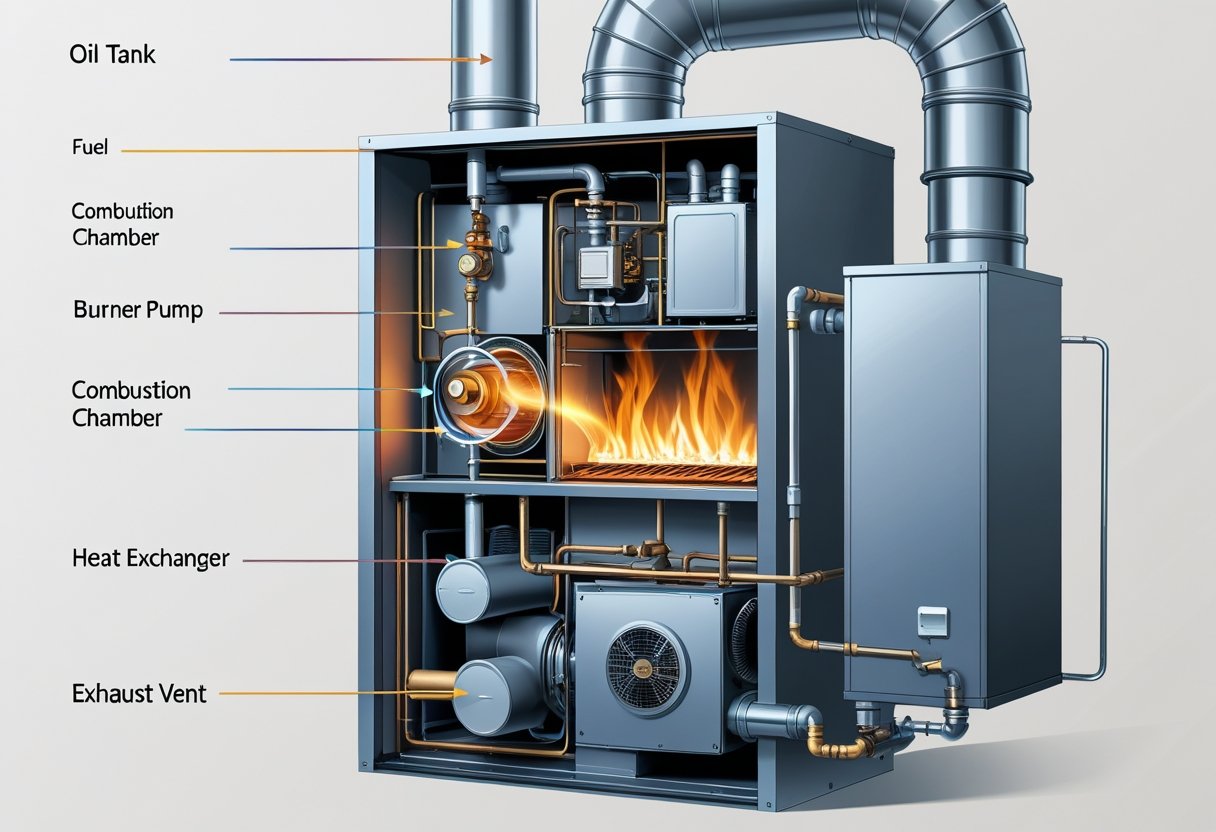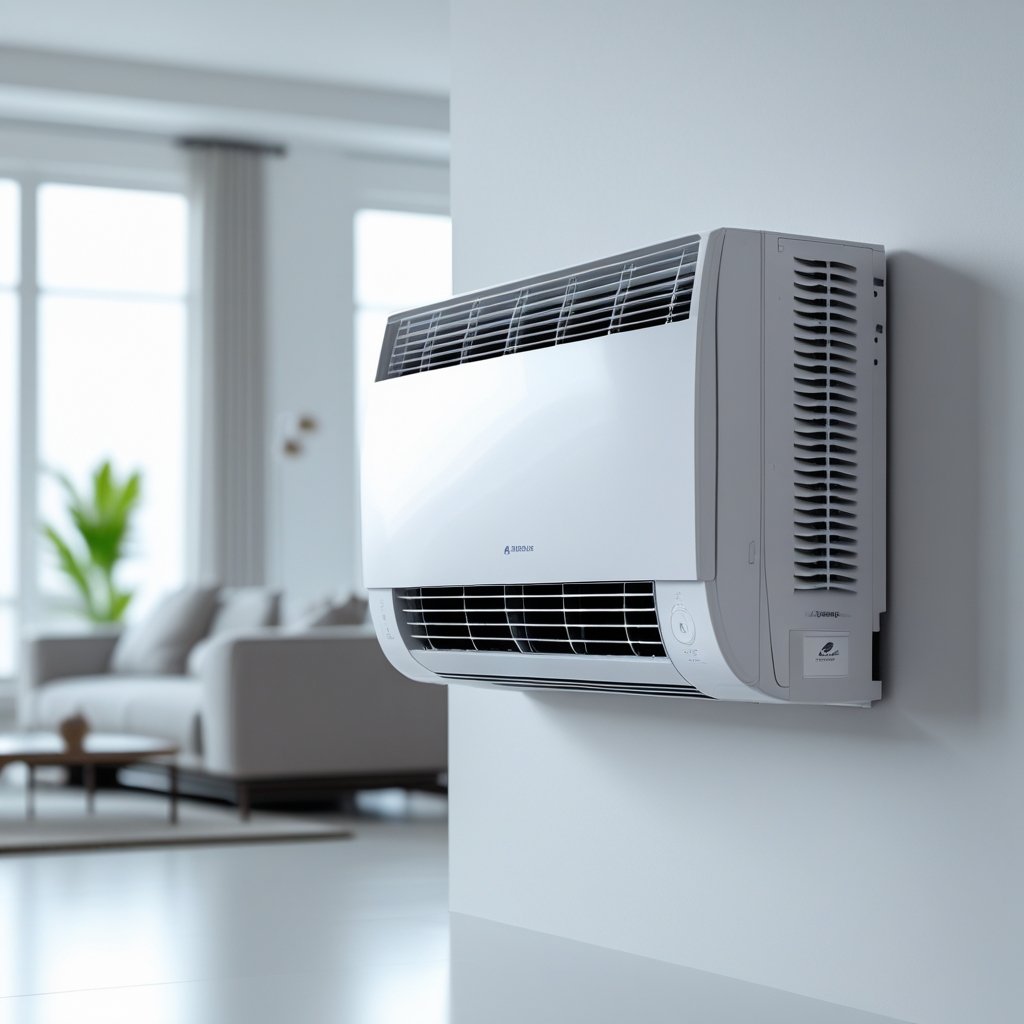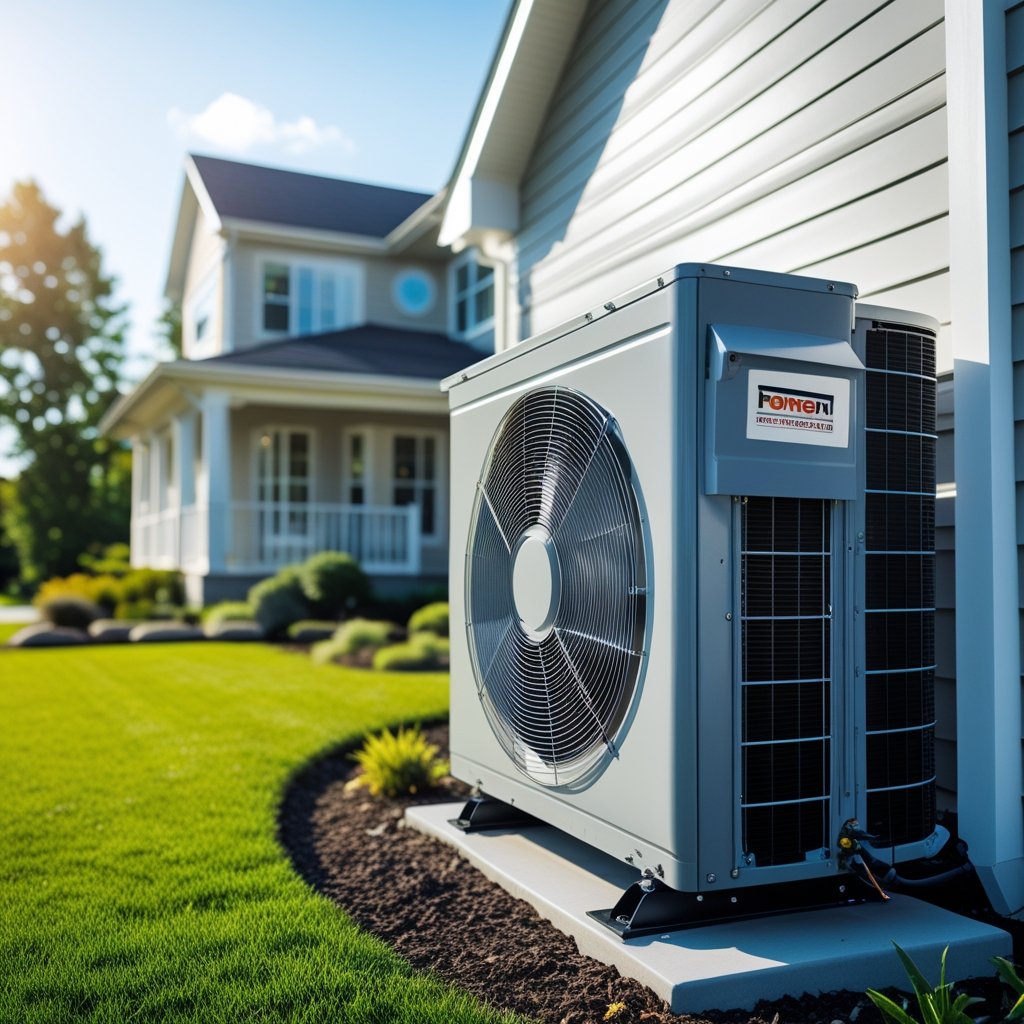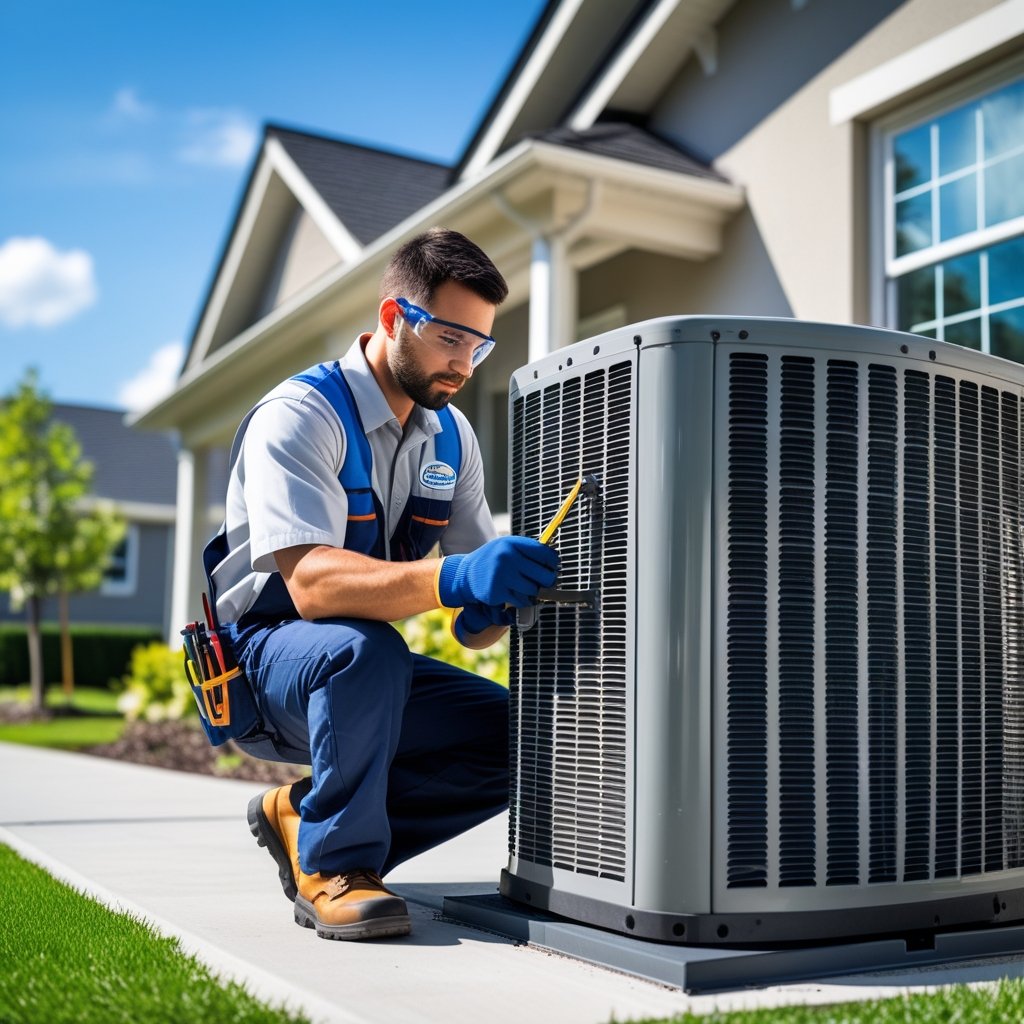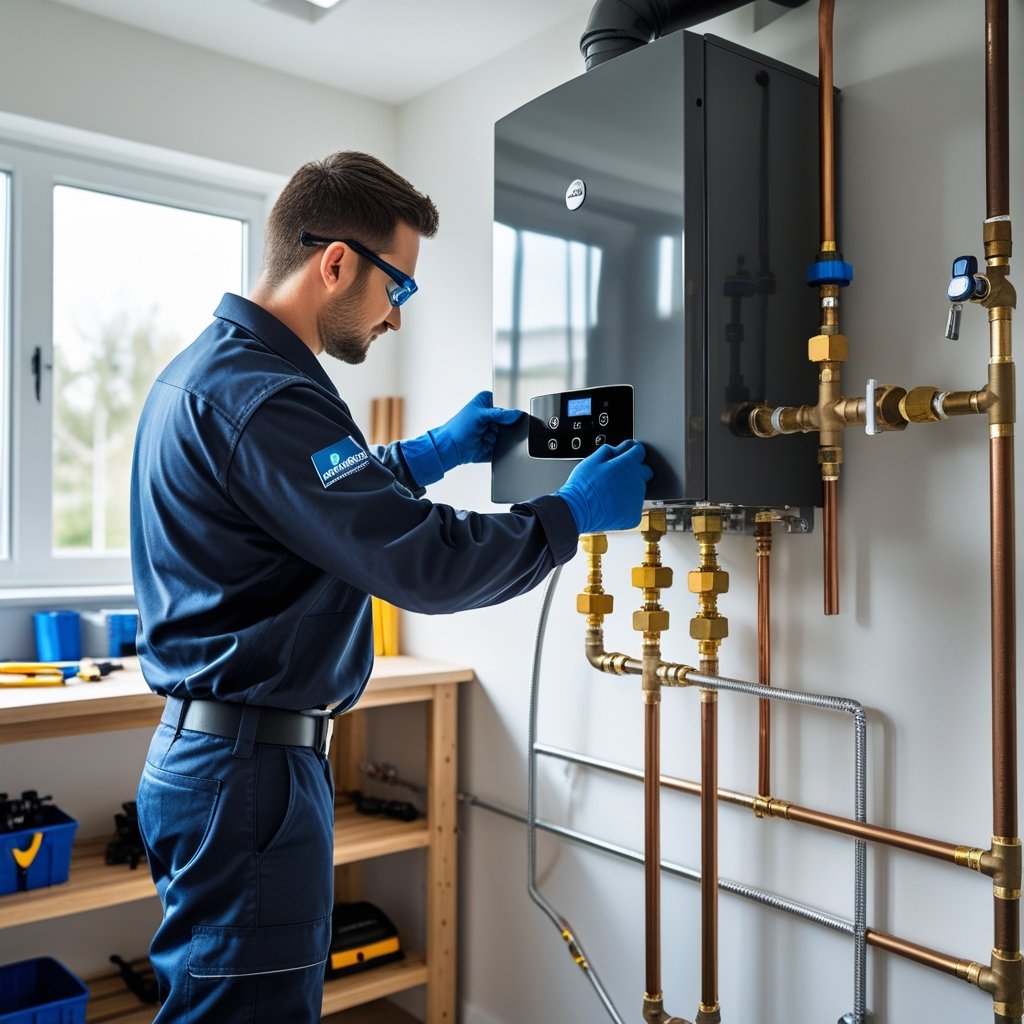An oil burning furnace heats your home by burning heating oil to create warm air. Inside the furnace, the oil is sprayed into a combustion chamber where it ignites, producing heat that warms air circulated through your ducts. That’s the basic idea—it’s what keeps your house cozy when the weather turns cold.
You count on the system’s parts working together. The burner, fuel pump, and blower all play their part to move oil, burn it safely, and spread heat. If you keep these components maintained, your furnace will usually run efficiently for years.
At Leo Kob Co., we get how critical reliable heat is for South Central Pennsylvania homes. Our licensed techs offer honest service and skilled care to keep your oil furnace humming, so you can enjoy steady warmth all winter.
What Is an Oil Burning Furnace?
An oil burning furnace works by burning heating oil to warm your home. It uses a few main parts to create heat and then moves that heat throughout the house. There are different types of oil furnaces, and you can use them in a variety of settings depending on your needs.
Basic Components
An oil furnace has some key parts that work together to keep you warm. The burner ignites oil for heat. The heat exchanger warms air without mixing oil fumes with your indoor air. A blower fan pushes that warm air through your ducts.
You also have a thermostat to control the temperature and an oil tank to store fuel. A pump moves oil from the tank to the burner. All these parts need regular checkups to keep your furnace running safely and efficiently.
Types of Oil Furnaces
You’ll mostly find two types of oil furnaces: gravity and forced-air. Gravity furnaces move warm air naturally, no fan involved. They’re pretty old-school and not so common now. Forced-air furnaces use a blower to push hot air through your ducts.
There’s also the choice between single-stage and two-stage burners. Two-stage models adjust the flame size for better efficiency. Picking the right furnace depends on your home’s size, insulation, and what you expect from your heating. Leo Kob Co. can help you sort out what’s best for your South Central PA home.
Common Applications
Oil furnaces are popular in places without natural gas service. In towns like Lancaster and Harrisburg, lots of folks rely on oil furnaces because they’re dependable in harsh winters. They’re also good for older homes where switching to gas might cost too much.
Some commercial buildings use oil furnaces too, especially if they need a steady, reliable heat source. Regular maintenance, like the service plans from Leo Kob Co., keeps these systems safe and helps lower heating costs. A little attention goes a long way toward steady warmth all winter.
How the Oil Burning Process Works
An oil burning furnace turns heating oil into warm air in a few steps. It’s all about getting oil to the furnace, turning it into a fine spray, and burning it safely and efficiently.
Oil Delivery and Storage
Everything starts with heating oil stored in a tank, usually outside or in your basement. A fuel company delivers the oil, so you don’t have to worry about running out.
Pipes carry the oil from the tank right to the burner. This setup means your furnace always has fuel when the temperature drops.
Leo Kob Co. suggests checking your tank regularly to avoid any surprises in winter. Good storage keeps leaks at bay and the oil clean, which helps your furnace last.
Fuel Atomization
Before the oil can burn, it has to become a fine mist—this is called atomization. The furnace uses a nozzle to spray the oil into tiny droplets. These mix with air to help the oil burn evenly.
A pump pushes the oil under pressure to the nozzle, which sprays it super fine. This helps the burner burn fuel more completely, making your furnace more efficient.
If atomization is off, you might get more soot or waste oil. That’s money out the window and more work for your furnace.
Ignition Sequence
The furnace lights the oil with a carefully timed ignition. First, an electric spark or hot surface igniter lights the atomized oil. At the same time, a fan blows air into the burner area to keep the flame going.
Once it’s lit, the flame heats a metal heat exchanger. Air from your home passes over this hot metal, warming up before heading through your ducts.
This process happens quickly and safely every time your thermostat calls for heat. Regular maintenance helps keep that ignition system reliable—nobody wants to wake up to a cold house.
Key Furnace Components and Their Roles
Your oil furnace has a bunch of parts working together to keep your place warm and safe. Each part does something specific to create and move heat efficiently. Knowing these helps you spot issues or know when to call for service.
Burner Assembly
The burner assembly is where the magic starts. It sprays oil into a fine mist and mixes it with air, creating a steady flame when it’s lit. The burner has a nozzle, spark electrodes, and a fan to push air in.
If the burner isn’t working right, your furnace will struggle to heat or use oil efficiently. Regular cleaning and checks from a company like Leo Kob Co. keep it in good shape.
Heat Exchanger
The heat exchanger takes heat from the burning oil and transfers it to the air in your home. Hot gases flow through this metal chamber, and the metal warms the air passing over it before it moves into your rooms.
Since the hot gases don’t mix with your indoor air, it’s safer and cleaner. If the heat exchanger gets cracks or rust, you risk carbon monoxide leaks, so regular checks are a must.
Combustion Chamber
The combustion chamber is basically the furnace’s firebox. It keeps the burning oil and flames safely contained. This chamber is made to handle high heat and direct hot gases through the heat exchanger.
It needs to be sealed tight to avoid leaks. Built from heat-resistant metal or firebrick, it can collect soot and debris over time. Ask your service provider to clean it during maintenance—keeping it clean helps your furnace burn oil more completely and reliably.
Airflow and Heat Distribution
How air moves through your house and spreads heat makes a big difference in how well your oil furnace works. The air handler and duct system play big roles. They help warm air reach every room evenly and efficiently.
Air Handler Operation
The air handler is kind of like the heart of your heating system. It pulls cool air from your home through return vents. Inside, a blower fan pushes this air over the heat exchanger warmed by burning oil.
This heated air moves into your ductwork and out to your rooms. You control the air handler with your thermostat. If it stops working, the furnace can’t deliver heat, so regular checks help keep things running.
A clean, well-maintained air handler means better air quality and efficiency. Change filters often—dust buildup can block airflow and make the blower work harder.
Ductwork in Oil Furnaces
Ducts carry warm air from the furnace all over your house. If they’re sealed and insulated right, heat won’t escape before it gets to you. Leaky or damaged ducts can mean cold spots and higher energy bills.
The size and layout of your ducts matter too. Ducts that are too small or have sharp bends slow air down, making the furnace work harder and burn more oil.
During service, Leo Kob Co. checks ducts for leaks and blockages. Fixing these helps your furnace heat your home faster and keeps energy bills down. Clean ducts also mean less dust and allergens floating around.
Control Systems and Safety Features
An oil furnace needs solid controls and safety systems to work well and keep you safe. These systems manage heat and protect your home from hazards. Knowing a little about them helps you understand how your furnace stays reliable.
Thermostat Functionality
The thermostat is the main controller for your oil furnace. It senses the temperature in your home and tells the furnace when to turn on or off. When your room drops below the set temp, the thermostat signals the burner to start.
The burner lights up and makes heat. The thermostat keeps checking the temp and shuts off the burner once your room is warm enough. This cycle keeps things steady and avoids wasting fuel.
You can adjust the thermostat easily. If you program it for different times of day, you can save energy by only heating when you need it. That’s a simple way to lower your bills and stay comfortable.
Safety Shutoff Mechanisms
Oil furnaces come with safety features that shut things down if something’s off. One is the flame sensor. It checks if the burner flame is steady. If the flame goes out, the sensor shuts off the oil to prevent leaks or dangerous fuel buildup.
Another is the limit switch. If your furnace gets too hot, this switch shuts it down to avoid damage or fire.
Leo Kob Co. tests and maintains these safety controls during furnace tune-ups. Regular checks of controls and blowers keep your furnace safe and running smoothly in South Central Pennsylvania homes.
Oil Furnace Efficiency and Maintenance
Keeping your oil furnace in good shape saves money and helps avoid breakdowns. If you know about efficiency, what service your system needs, and signs of trouble, you’ll get more years and better performance from your furnace.
Efficiency Ratings
Oil furnaces have efficiency ratings called AFUE (Annual Fuel Utilization Efficiency). This shows how much fuel becomes heat. For example, an 85% AFUE furnace turns 85% of oil into heat, losing the rest. Old furnaces are usually less efficient, sometimes under 80%. Newer models can hit 87-90%.
Higher efficiency means lower fuel bills and less pollution. Getting a newer, efficient furnace may qualify you for energy rebates in South Central PA. Still, even top models need regular upkeep to keep their rating. Leo Kob Co. helps you get the most from your system with routine service.
Routine Service Needs
To keep your oil furnace efficient, schedule yearly tune-ups. A skilled technician will clean key parts like burners and heat exchangers. They’ll check oil nozzles, filters, and the fuel pump for wear or leaks. This stops buildup that wastes oil or damages the system.
Changing the oil and air filters keeps airflow smooth. Your Leo Kob Co. tech also checks safety controls and the thermostat. Good maintenance lowers the risk of breakdowns and helps your furnace last. Think of yearly service as a small investment for a warmer, more reliable winter.
Signs of Troubles or Repairs
Keep an eye (and nose) out for signs your oil furnace needs attention. Uneven heat or odd smells could mean clogs or burner trouble. If your furnace cycles on and off too much or makes banging noises, you might have a clogged nozzle or a failing part. Yellow or flickering flames instead of steady blue ones show poor combustion, which wastes oil and risks carbon monoxide.
If your oil bills go up without colder weather, that’s a red flag for efficiency loss. And if your furnace struggles to start, don’t wait—call a pro. Leo Kob Co.’s licensed techs can spot problems early and fix them before they get worse. Don’t ignore warning signs; timely repairs keep your home safe and comfortable.
Comparing Oil Furnaces to Other Heating Systems
Choosing a heating system affects your comfort, costs, and how much work you’ll need to put in for upkeep. It’s worth knowing how oil furnaces stack up against gas models and what unique perks oil heating brings to your home.
Oil vs. Gas Furnaces
Oil furnaces burn heating oil for heat, while gas furnaces rely on natural gas. Oil packs a punch—per unit, it puts out more heat. If you live somewhere chilly, like South Central Pennsylvania, that’s a real advantage.
Gas furnaces, on the other hand, heat up quickly and burn cleaner since natural gas is more efficient. But oil furnaces don’t tie you to a gas line. You’ve got your own storage tank, so you decide when to fill up and how much to buy.
Considerations for you:
- Oil heating costs swing with fuel prices.
- Gas furnaces usually need less maintenance.
- Oil furnaces need regular cleaning for the burner and chimney.
- You can store oil outside and avoid supply interruptions.
Advantages of Oil Heating
Oil heating doesn’t care if there’s a gas line nearby. If your home’s off the grid, you’re still covered. You can manage fuel deliveries on your own schedule.
Oil boilers and furnaces crank out strong, steady heat—perfect for harsh winters. Your place warms up fast and stays comfortable.
With good maintenance, oil furnaces tend to last. Leo Kob Co. can handle the routine checks that make a difference. Around Lancaster and Harrisburg, lots of folks stick with oil for its reliability.
Extra points to know:
- Oil heat can keep running during power outages if your furnace has a standing pilot.
- Outdoor oil tanks free up indoor space.
- Depending on where you live, oil systems might qualify for rebates.
Curious if oil heat makes sense for your home? Give Leo Kob Co. a call and we’ll talk it through.
Environmental Impact of Oil Heating
Oil heating systems put out more carbon dioxide than natural gas or electric setups. That means more greenhouse gases, which isn’t great for air quality or climate.
Burning oil also releases sulfur dioxide and nitrogen oxides—small amounts, but enough to add to smog and breathing issues, especially if lots of homes use oil.
Here’s what to keep in mind about oil heating’s environmental effects:
- Carbon emissions: Higher than most fuels
- Air pollutants: Sulfur dioxide, nitrogen oxides, and particulates
- Fuel spills: Can lead to soil and water contamination
A modern, well-tuned oil furnace helps cut down on emissions. Regular tune-ups mean cleaner burning and better efficiency, which saves you money and hassle. At Leo Kob Co., we recommend yearly maintenance to keep things running right.
If you’re worried about your environmental impact, maybe look into high-efficiency oil models or hybrid systems. We’re happy to walk you through rebate programs and energy-saving upgrades.
Frequently Asked Questions
Knowing how your oil furnace works lets you keep your home warm and your system happy. Understanding the main parts, how it can hook up to your hot water, and what to do if you run out of oil can save you headaches.
What are the main components of an oil burning furnace?
Your oil furnace has a few key parts: burner, combustion chamber, heat exchanger, blower, and thermostat. The burner mixes oil and air, then ignites it. That heat moves through the exchanger, and the blower pushes warm air all over your house.
How can you integrate an oil furnace with a domestic hot water system?
You can hook up your furnace to a hot water tank using an internal coil. The furnace heats water as it runs, so you get hot showers and taps without a separate heater. It often saves space and energy.
What is the expected lifespan of an oil burning furnace in a home?
Most oil furnaces last about 20 to 30 years if you keep up with maintenance. Regular checkups from companies like Leo Kob Co. help your furnace run efficiently and stick around longer.
What steps should you take if your oil furnace runs out of oil?
If you’re out of oil, refill the tank as soon as you can. After that, you might need to bleed the fuel lines to get rid of air and restart the burner. Not sure how? Leo Kob Co. technicians can handle it for you.
What are some common drawbacks of using an oil heating system?
Oil furnaces need a storage tank and regular fuel delivery, which can get messy or take up space. Oil prices jump around and sometimes cost more than other fuels. You’ll also need to schedule deliveries and keep up with cleanings to stay safe.
What voltage is typically required to operate an oil-fired furnace?
Most oil furnaces run on your basic household voltage—120 volts. That’s what powers the controls, blower fans, and ignition. Honestly, it’s pretty convenient since you don’t need any special wiring; you just plug it into the usual home electrical setup.

